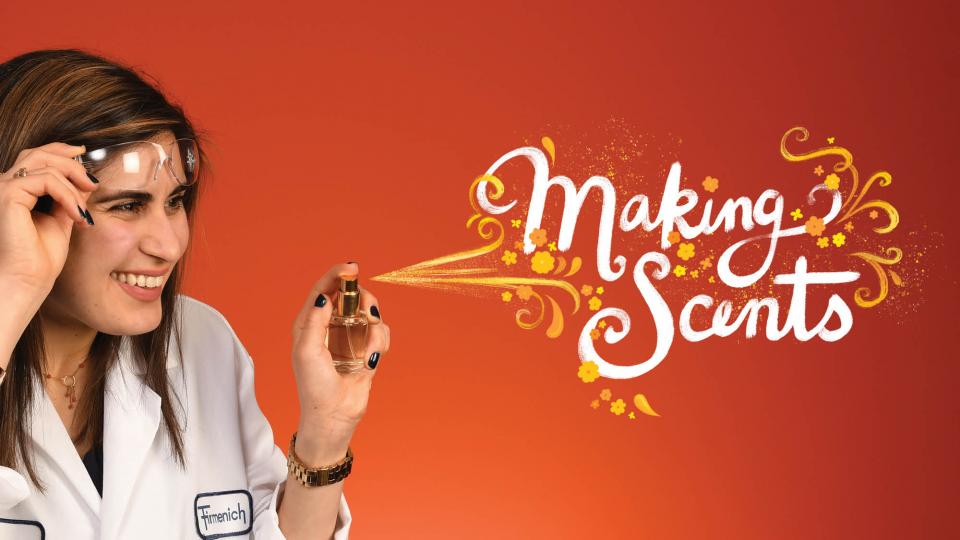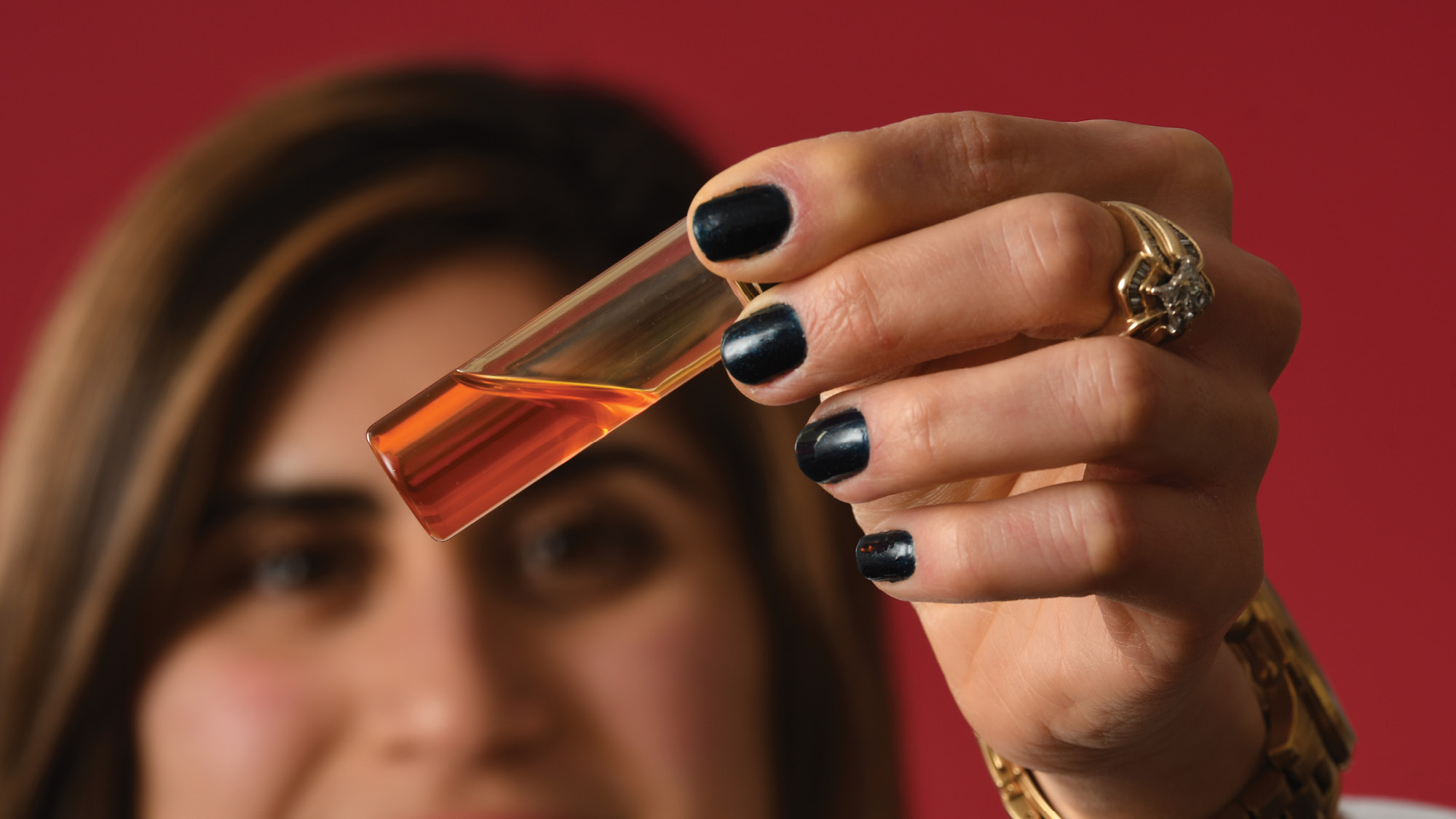by Adam Grybowski
One day during a job interview in November 2014, Kathleen Eliya ’14 named Estee Lauder Pleasures as her favorite perfume. Eliya had earned a degree in chemistry from Rider University and was working as a lab technician at Firmenich, the global giant that has created iconic fragrances and flavors for more than 100 years. The job she was interviewing for — a master perfumer’s assistant — would be a promotion.
She was asked to describe the perfume, a landmark bestseller that was originally released in 1995.
The creation of a fragrance is part art, part science. Perfumers, the people who create fragrances, design them to unfold over time, like pieces of music. And like in a piece of music, the individual parts that make up a fragrance are called “notes.”
The top notes come first, light and quick to fade. Citrus scents make popular top notes, providing a bright introduction to a fragrance. As they begin to evaporate, the middle notes — often floral, fruity or redolent of herbs — move in. Finally, they combine with the base notes. Vanilla, musk and sandalwood are common base notes. Lingering longest and leaving a lasting impression, they are often what you remember when you think of the fragrance.
Tasked with describing the creations of perfumers, marketers gravitate toward the idea of a journey. On the website of Estee Lauder, Evelyn Lauder describes Pleasures as “a fragrance that unfolds like a flower in the warmth of the sun, surrendering its scent little by little.”
Pleasures is indeed a concoction of lilies, peonies and jasmine and several other flowers, and in her interview, Eliya took the time to describe the qualities of its various notes, summarizing that the perfume had an overall calming effect on her mood.
She recalls the interviewer — a woman, Annie Buzantian, who had reached the pinnacle of her profession and was officially a fine fragrance master perfumer — taking in her answer and then, astonishingly, revealing that she was the creator of Estee Lauder Pleasures.
“My mind was blown,” says Eliya, who got the job and would eventually become the master perfumer’s assistant.
Behind every fragrance is a team of individuals rigorously designing, selecting and testing just the right combination of ingredients to create a particular scent and accomplish a desired effect. Their work plays a ubiquitous role in our lives, whether we care to realize it or not. Not everyone has a bottle of fine perfume or cologne in their bedroom, but other products — cosmetics, candles, soaps, shampoos, lotions, laundry products — are inescapable.
Several of the world’s major flavor and fragrance companies have a presence in New Jersey. In addition to Swiss companies like Firmenich and Givaudan, International Flavors & Fragrances from the United States, Robertet from France, Symrise from Germany and Takasago from Japan all operate in the state. Eliya’s story represents how alumni of Rider’s chemistry program have taken advantage of that fact to leverage their science education into a career that supports the creation of fragrances. As a master perfumer’s assistant, she helps realize the vision of a new product by moving it from formula to fragrance. Each day, she works in a lab, manipulating a vast array of natural and synthetic chemicals drawn from the company’s impressive library.
The process can be extraordinarily complex. When selecting an ingredient for citrus, for example, it could take the form of lemon, lime, grapefruit or a dozen other citrus fruits. Eliya estimates that perfumers easily have more than 100 options when it comes to selecting a citrus scent. Overall, perfumers have access to more than a thousand ingredients at their disposal.
When all is said and done, “There can be 50 components in a bath and body product, and fine fragrance can have a hundred or more components,” says Caryl Yeager ’67, another alumna of the University’s chemistry program who spent the majority of her career at Givaudan, the world’s largest company in the flavor and fragrance industries, and also operated her own fragrance consulting firm until her retirement in 2015.
Yeager became an expert on designing experiments that evaluated people’s sensory perceptions of fragrance products in development. Over the course of her career, she came into contact with many sides of fragrance creation. The work is not all perfume and cologne. The technical function of fragrances in some products is to neutralize bad odors and replace them with something more pleasing. Think of cat litter, candles or air fresheners. “When you create deodorant,” Yeager says, “the fragrances that go into it are designed to counteract body odor. A lot of basic research goes into that.”
Marketing fads also play a major role in the in the creation of fragrances. French fragrance houses have long dominated the industry, and though they continue to set industry trends, many other variations are prevalent. “Preferences vary from country to country, and they change over time and with the season,” Eliya says. As a consultant, Yeager worked directly with companies making consumer products as well as fragrance houses. She witnessed over her long career the ups and downs of several trends. The effect retailer Bath & Body Works had on the industry in the 1990s stands out in her mind. “They capitalized on making all things fruity,” she says. “Everyone else wanted to jump in.”
Yeager’s work was a far cry from the career trajectory set forth for her in the 1960s when she was in high school. Training to be a secretary, she learned in high school she couldn’t type well. Then, in her junior year, she was placed in advanced chemistry class and realized she loved the logic of the science, the way molecules fit together, the way it all made sense.
When Yeager graduated from Rider, she was interested in pharmaceutical research. She pursued that kind of work for several years but ultimately learned that laboratory work was never going to satisfy her. A job at Avon got her out of the lab and launched her into the fragrance industry.
Science, on the other hand, interested Eliya from the time she was a little girl dreaming of becoming an astronomer. By the time she enrolled at Rider as an undergraduate, that passion for stars and planets cooled and she had a new dream: graduating with a degree in biology, going to medical school and eventually working as a pediatric doctor. Despite her intentions, she found herself drawn to chemistry more than biology. She was fascinated by the intriguing ways chemicals could combine to form something familiar, such as the way sodium and chlorine could form table salt.
“My brain was so intrigued,” she says. “It was the most incredible thing in the world, and I became very passionate about chemistry.”
One day, Eliya turned over a bottle of lotion and read the ingredients. “I thought, ‘Whoa.’ This was science, this was chemistry, and it was creative as well,” she says. “From that point on I wanted to be a cosmetic chemist.”
Inside the lab or out, one attribute required for a successful career in fragrance is a sophisticated sense of smell. Not everyone is born with one. With training though, most people can vastly improve their ability to detect and identify the features of fragrance. At the pinnacle of her career, Yeager’s sense of smell was second to none. A few years into retirement, however, she says, “Without continued practice, my sense of smell isn’t as sharp as it used to be.”
Eliya, only a few years into her career, says her sense of smell has never been so refined, that eating and drinking wine has become more pleasurable as a result, and that she can hardly go to the store without stopping and smelling each individual candle and all the rest of the products that are defined in large part by the work she does.
She recalls one afternoon when she was out shopping and suddenly became aware of a familiar fragrance when a woman walked passed her. It was Decadence, a perfume released by Marc Jacobs in 2015, which Eliya had worked on. On impulse, she stopped the woman to confirm if her assessment was correct. “I’m sorry to bother you, but are you wearing Marc Jacobs Decadence?” Eliya asked.
Impressed, the stranger nodded and then replied with a question of her own, “How did you know?”
Eliya smiled and said, “I made that.”


